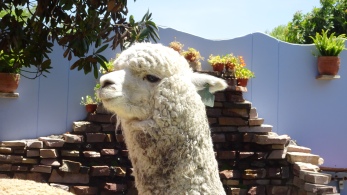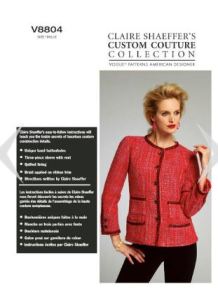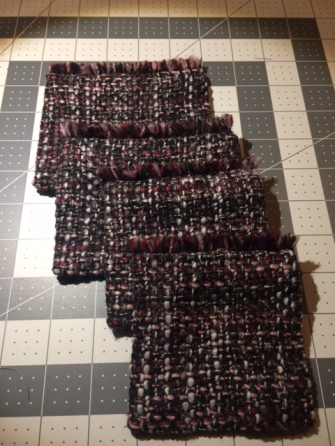
What’s in your closet? In terms of fabrics, I mean. Do you have more natural fibres represented, or are you a synthetics lover? Do you even know the precise fabric content of every piece of clothing? If you fabricate your own clothes, do you always ask about the fibre content if it isn’t clearly indicated on the bolt? I’ve always been interested in fabrics and never buy a piece of clothing without checking the label. Of course, one reason to check is to see how to care for it. Dry clean only? Hand wash? Machine wash and dry? It makes quite a difference. But for me there’s much more to it than that.
When it comes to sewing my own clothes, I am always working at improving my ability to figure out which fabrics work well with which designs. Does it drape? Wrinkle? Stretch? Should it drape, wrinkle or stretch? But there’s another important factor: I’m interested in how a fabric feels next to my skin; this has always been important to me, but even more so as I get older. From a style perspective, feeling good in one’s clothes is almost as important as a flattering colour or a perfect fit in my view. When I’m uncomfortable, I fidget with my clothes, and I wager that you do, too. That’s why when I have an opportunity to examine a new-to-me kind of fabric, I’m there: feeling, scrunching, gently pulling. You know, just what you do.
It’s not that long ago that learned about cupro (I know, I’m late to the party), and most recently I made it a point to learn about alpaca. My husband and I have just returned home from a trip that took us through the Panama Canal and down the west coast of South America, spending a week or more in Peru and ending up with eight days in Chile. Before we left, I had already done some research on alpaca because I knew that in all the world, Peru is the hot-spot for alpaca fibre and clothing.
For years I have coveted alpaca outerwear…
[A Max Mara alpaca coat on the left; a Sentaler – a favourite of the Duchess of Cambridge – on the right]
The drape and softness of alpaca and alpaca-blend fabrics make for some of the most luxurious coats on the planet as far as I’m concerned. And there’s that warmth-without-weight that is so welcome in those cold Toronto winters.

In the case of fabrics for coats, alpaca is almost always blended with virgin wool (100% alpaca fabric is very expensive – see below!). Where I’ve often seen 100% alpaca is in knitwear, and when we headed to Peru, it was knitwear that was on my mind. I wasn’t disappointed.
While we were in Lima, we had the pleasure of having a private guide (if you want to read about our experience more fully, you can click here and you’ll find yourself smack in the middle of the travel blog I keep with my husband). One of the great advantages of private guides is that the tour you get is a bespoke one based on your interests and desires. One of my desires was to see if I could find an alpaca scarf and/or sweater in a high-end shop. The reason I stipulated high-end is that there is alpaca of a wide variety of qualities on offer in Peru. You can buy a sweater from a kiosk on the street (or the cruise ship pier) where, at best, you might find a design that will forever remind you of your Peruvian adventure (while you scratch yourself vigorously), or you can plan to pay more and find a baby alpaca sweater, hat or scarf that is a dream to wear forever. I am firmly in the latter camp.
Anyway, on that day in Lima, our guide deposited us at the end of the day at Kuna, one of best known alpaca purveyors in Peru, Chile and beyond – they have an online shop that I had spent some time perusing long before I ended up in Lima. That day, however, as nice as the shop was, I didn’t find the right piece in the right size.
I did find a wonderful baby alpaca scarf (60% baby alpaca, 30% pima cotton, 10% nylon), though, at a converted mansion filled to the brim with artisanal, hand-woven baby alpaca among many other beautiful things.
But we still had almost two weeks in Peru and Chile and I knew there would be other opportunities. Then I found myself in Arequipa.
Some 7700 feet above sea level in the Andes mountains, Arequipa is a city that you can reach only after a two-hour drive inland from the coast through the Atacama Desert. Our first stop was Sol Mundo.

We visited a few alpacas and lamas, the origin of the fibres, then we learned about the sorting and combing process. Like sheep, alpacas are sheared yearly and their wool obviously replenishes itself – a renewable resource if ever there was one! Baby alpaca wool is the finest of all, so soft to the touch.

Then we found ourselves in their shop. What a beautiful feeling to be surrounded by garments crafted of some of the finest alpaca wool in the world. I was on the hunt for a cardigan (I know, that makes me sound old, but cardigans are the next best thing to soft, tailored jackets. Just ask Chanel!).
I was trying on my usual plain black and navy in the midst of a riot of colours when my husband, one of the best shopping companions in the world – I think I could make a lot of money pimping him out as a shopping companion/consultant – beckoned my over to the opposite side of the shop. He had found what he thought was the perfect compromise for me – a compromise between my penchant for plain neutrals and the riotous colours on offer. He was right.

Fabricated of the softest baby alpaca, the sweater displayed muted shades of grey and black in a print reminiscent of the sweater’s Andean provenance. The fact that it has interesting design details, too, was cause for celebration. There were details of grey, felted baby alpaca down the front button placket, in triangles on the cuffs and as elbow patches. We had a winner! And they threw in a hand-crafted baby alpaca scarf in my choice of colours – of course I chose neutral beige!
I won’t lie: I’m still hankering to find some lengths of alpaca or alpaca-blend fabric to make a coat. Yes, there are online places I can get it (Mood offers a 100% alpaca coating for $99.99 a yard! Also a 65% wool and 35% alpaca blend for $35.00 a yard). But that’s a project for next year. This winter I’m gong to try to take apart my husband’s old tuxedo and refashion it for me. Yeah, really.
Sol Alpaca: https://www.solalpaca.com/store/
















 and in her book, so what to do? I was left only one choice: doing hand-worked buttonholes through both the fabric and lining, an approach that you do, indeed sometimes see in couture garments, but that when done by an amateur can look dreadful. I would have to spend some time learning. So, I made up some samples and start the process. It took me two weeks.
and in her book, so what to do? I was left only one choice: doing hand-worked buttonholes through both the fabric and lining, an approach that you do, indeed sometimes see in couture garments, but that when done by an amateur can look dreadful. I would have to spend some time learning. So, I made up some samples and start the process. It took me two weeks.







You must be logged in to post a comment.